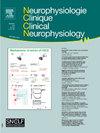Effect of transcranial direct current stimulation on tinnitus modulation: A randomized, double-blind, and placebo-controlled clinical trial
IF 2.7
4区 医学
Q2 CLINICAL NEUROLOGY
Neurophysiologie Clinique/Clinical Neurophysiology
Pub Date : 2024-10-25
DOI:10.1016/j.neucli.2024.103020
引用次数: 0
Abstract
Objectives
To evaluate the short and long-term effects of anodal tDCS (a-tDCS) targeting the left temporoparietal area (LTA) on tinnitus severity, annoyance, and loudness.
Methods
This is a double-blind, randomized, sham-controlled, and parallel-group clinical trial. A total of 42 individuals with tinnitus were randomized to a-tDCS (n = 24) or sham tDCS (n = 18). The a-tDCS group received tDCS over the LTA during five consecutive day sessions (2 mA, 20 min). The sham group received a placebo current with the same characteristics as the a-tDCS group. Participants were assessed at baseline, after the fifth session, and at the 30-day follow-up, using hearing assessments and symptom questionnaires.
Results
There was no effect of comparison between groups or interaction effect (time x group) in all hearing assessments and symptom questionnaires. There was only a main effect of time for Tinnitus Handicap Inventory - THI [F(1.642, 45.988) = 5.128; p = 0.014; η2 = 0.155]. Bonferroni post hoc showed that there was a significant difference in THI in the sham group between pre and post-treatment [CI (0.107, 14.643; p = 0.046)]. However, there was no difference between pre-treatment and follow-up THI, or between post-treatment and follow-up THI. There was no treatment effect on tinnitus severity (assessed by Tinnitus Functional Inventory - TFI), tinnitus annoyance or loudness (assessed by Visual Analogue Scale - VAS), or tinnitus pitch, loudness or minimum masking level (assessed by tinnitometry).
Conclusion
Five consecutive sessions of a-tDCS targeting LTA do not improve tinnitus severity, annoyance, and loudness. Future studies should investigate if other tDCS protocols are effective or a combination of tDCS with other forms of treatment.
经颅直流电刺激对耳鸣调节的影响:随机、双盲和安慰剂对照临床试验:经颅直流电刺激对耳鸣调节的影响:临床试验。
目的评估以左侧颞顶区(LTA)为靶点的阳极tDCS(a-tDCS)对耳鸣严重程度、烦恼和响度的短期和长期影响:这是一项双盲、随机、假对照和平行组临床试验。共有 42 名耳鸣患者被随机分配到 a-tDCS 组(24 人)或假 tDCS 组(18 人)。a-tDCS组连续五天在LTA上接受tDCS治疗(2毫安,20分钟)。假电流组接受与 a-tDCS 组相同的安慰剂电流。在基线、第五次治疗后和 30 天随访时,使用听力评估和症状问卷对参与者进行评估:结果:在所有听力评估和症状问卷调查中,组间比较或交互效应(时间 x 组)均无影响。只有耳鸣障碍量表(THI)存在时间主效应[F(1.642,45.988)=5.128;p=0.014;η2=0.155]。Bonferroni post hoc 显示,假治疗组的 THI 在治疗前和治疗后有显著差异 [CI (0.107, 14.643; p = 0.046)]。但是,治疗前和治疗后的 THI 之间以及治疗后和治疗后的 THI 之间没有差异。治疗对耳鸣严重程度(通过耳鸣功能量表评估)、耳鸣烦扰度或响度(通过视觉模拟量表评估)、耳鸣音高、响度或最低掩蔽水平(通过耳鸣测量法评估)均无影响:结论:以 LTA 为目标的连续五次 a-tDCS 治疗并不能改善耳鸣的严重程度、烦扰度和响度。未来的研究应探讨其他 tDCS 方案是否有效,或将 tDCS 与其他治疗方式相结合。
本文章由计算机程序翻译,如有差异,请以英文原文为准。
求助全文
约1分钟内获得全文
求助全文
来源期刊
CiteScore
5.20
自引率
3.30%
发文量
55
审稿时长
60 days
期刊介绍:
Neurophysiologie Clinique / Clinical Neurophysiology (NCCN) is the official organ of the French Society of Clinical Neurophysiology (SNCLF). This journal is published 6 times a year, and is aimed at an international readership, with articles written in English. These can take the form of original research papers, comprehensive review articles, viewpoints, short communications, technical notes, editorials or letters to the Editor. The theme is the neurophysiological investigation of central or peripheral nervous system or muscle in healthy humans or patients. The journal focuses on key areas of clinical neurophysiology: electro- or magneto-encephalography, evoked potentials of all modalities, electroneuromyography, sleep, pain, posture, balance, motor control, autonomic nervous system, cognition, invasive and non-invasive neuromodulation, signal processing, bio-engineering, functional imaging.

 求助内容:
求助内容: 应助结果提醒方式:
应助结果提醒方式:


